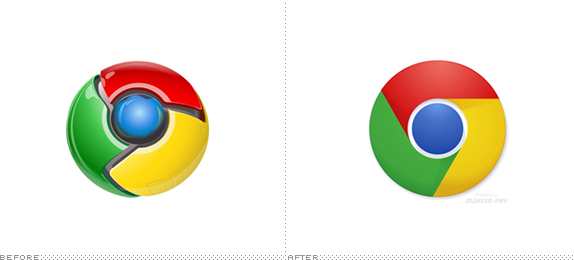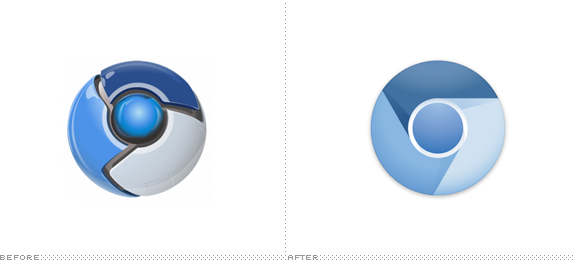From the dark ages to this day.

Posts Tagged ‘chrome’
Chrome Loses Volume

First released for Windows XP in December of 2008, Google Chrome is a browser developed by, yes, Google. Versions for Mac OS X and Linux followed a few months later and since then Chrome has become one of the most popular browsers — 19.26% of you are reading Brand New on Chrome, in third "place" behind Safari and Firefox. Chrome's most current stable release is version 10.0.648.134 (but you knew that, right?) and currently in development is dev version 11.0.696.12 which is not released to the public yet but for those that are taking it for an early spin they have gotten a glimpse at the new logo for Chrome. The new logo for Chrome surfaced after a new logo for Chromium — the open source version of Chrome — made its debut earlier this year.

It's certainly nice and welcome to move away from logos that looked as if they came out of a mash-up of Fisher-Price and Tron and the new "abstract," flat logos are slightly slicker but there is still something odd about them. There is shading still involved, so dimension is meant to be implied, yet it's hard to tell what that dimension is supposed to be. If the light source is coming from above, how come there are shadows being cast from bottom to top as seen in the green-to-red transition? The red-to-yellow pane indicates one kind of dimension but the rest doesn't follow. Realistic dimension is not about taking one shape and step-repeating it, shadow and all, a couple of times to form the circle. The previous versions of Chrome and Chromium were garish but at least it was clear what the dimension was. With the new ones, Google tried some kind of compromise between full 3D rendering and flat and it didn't quite pay off. Maybe I'm just misinterpreting what I'm seeing or trying to extract too much sense out of it — indeed, I'm just glad for the move towards simplicity.
Thanks Lucian Marin for first tip.

Don't forget to cast your vote about this post online

Cortex for Chrome Makes Sharing Faster, Prettier & More Fun Than Ever [EXCLUSIVE]
We’re having a blast tonight playing with Cortex, an insanely fast, beautifully built extension for Google Chrome. It’s lightweight as all get-out, and it lets you share content all over the web literally faster than you can say, “Hey, look at this.â€
Here’s the gist of it: Install the extension, find content you want to share, then click and hold. When you do, your mouse will be surrounded by a wheel of options. Flick your mouse in the correct direction, release your finger and voilà , your content is shared to Twitter, to Tumblr, to a specific Facebook friend’s wall — wherever you desire — accompanied by a charming “whoosh†sound.
The entire process takes about two seconds, and it’s as good-looking as it is fast.
The Cortex interface is incredibly unique. We’re generally big fans of apps that get out of your way when you don’t need them; we love it when features are unobtrusive and recede gracefully.
In that sense alone, Cortex is the perfect antidote to the array of hideous sharing mechanisms that populate the web today — those obnoxious bars, frames and buttons that clutter up the visual space and make your eyes long for rest. From a design perspective, Cortex is a breath of entirely fresh air.
In terms of user experience, the extension also makes sharing incredibly easy for users. It chooses header text and shortens URLs; it even lets users share just an image or specific selected text. Cortex also lets you track your history of shares. The only thing we wish worked a tad better is image sharing; right now, Cortex sends a link to Twitter and Facebook when we try to share images.
Right now, you can share to Facebook, Twitter, Tumblr and Instapaper. More options will be coming soon.
Here’s a brief demo video that shows how Cortex works:
Cortex was just launched along with the all-new Chrome Web Store. It comes from the brain of Google intern-turned-entrepreneur Joey Primiani, who said in an e-mail, “Learning from building successful products at Google, I love focusing on things people use on a daily basis. It’s a technology that I think is really focused, very simple and useful.â€
Expect to see tablet and mobile features for Cortex soon. In the meantime, give it a shot and let us know in the comments what you think.
Demo video courtesy of Good Morning Geek.
Reviews: Facebook, Google, Tumblr, Twitter, instapaper
More About: chrome, chrome extension, cortex, Google, joey primiani, trending
For more Social Media coverage:
- Follow Mashable Social Media on Twitter
- Become a Fan on Facebook
- Subscribe to the Social Media channel
- Download our free apps for Android, iPhone and iPad
Chrome Lets You Remove Your Flash and Have It, Too
Change Any Web Page’s Design Instantly with Chrome Extension Stylebot
One of our favorite web browsers just got a cool new tool in the form of Stylebot, a new Chrome extension that allows you to access and modify the CSS for any web page from within the browser.
That’s right — users get a completely customized design experience for any page they choose. The changes they make can be saved for later use and synced across multiple devices.
This is great news for you design enthusiasts as well as for end users with specific needs and wants for their browsing experience. For example, the extension makes web pages with small fonts more accessible by allowing users to increase the font size, and it can make browsing the web less commercial by removing ads.
Stylebot generates a sidebar full of basic and advanced CSS options that allow the end user to manipulate how content is displayed. This tool is simple enough to be used by a moderately competent consumer, but it also has options better suited for those with web design skills. Stylebot can be used to change font attributes, remove advertising, move page elements, change colors, write one’s own CSS selectors and quite a bit more.
Googler Rachel Shearer wrote the following today on the company’s blog:
“For example, a Stylebot user with special reading needs might change a webpage by removing images, picking new text and background colors, and even moving blocks of text around. And Stylebot saves the custom style they create, so the next time they access that page the changes will still be there. Even better, they can sync their saved styles across computers so that webpage will always appear with their preferred style.â€
Check out this brief demo video to see Stylebot in action:
Stylebot was created as a Google Summer of Code project by Ankit Ahuja, a computer science student in New Delhi, India. Stylebot is open source and forkable; interested parties can check out Ahuja’s source on GitHub. He said he used elements of other open-source projects, such as Aristo and Firebug, in his work.
What do you think of Stylebot so far? Would you use it to prettify the ugliness that is Craigslist, for example, or to simplify content viewing on a news site?
Reviews: Craigslist
More About: accessibility, chrome, chrome extension, Chromium, CSS, design, designers, Google, google chrome, stylebot, web design
For more Dev & Design coverage:
- Follow Mashable Dev & Design on Twitter
- Become a Fan on Facebook
- Subscribe to the Dev & Design channel
- Download our free apps for iPhone and iPad







